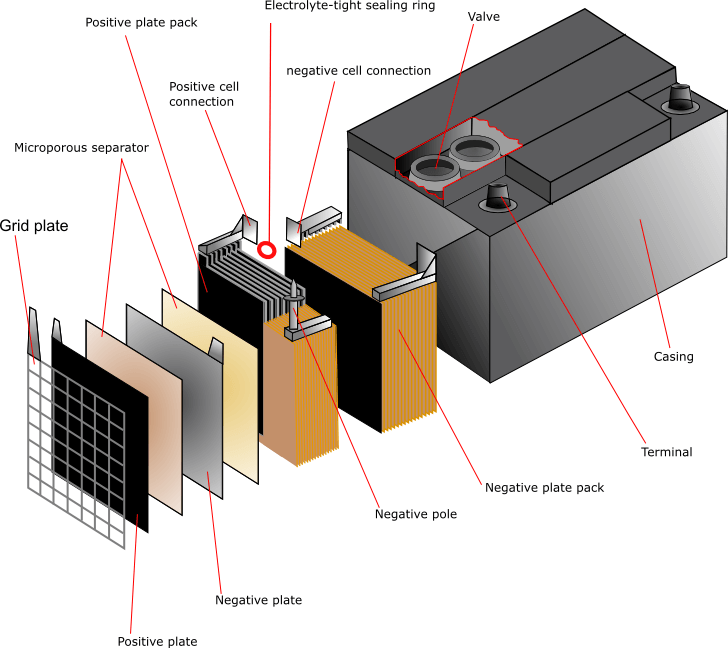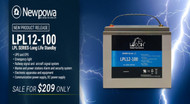DEEP CYCLE AND AGM BATTERY INTRODUCTION
21st Sep 2021
Deep Cycle and AGMBattery Introduction
Deep cycle batteries are a type of lead acid battery and are known as the marathon runners of the battery world. Rather than a short burst of lots of power, they supply a lesser amount of power for long periods of time. Deep cycle batteries are common among people who own RVs or Boats and is also seen used with golf carts and solar panel systems. Absorbed glass-mat (AGM) battery is also a lead acid type with a similar approach to the deep cycle working mechanism. An AGM battery is designed for two jobs: delivering powerful bursts of starting amps and running electronics for a long time.
All batteries will have these two slopes, which will determine the other battery specs:
· CCA, or Cold Cranking Amps – this refers to the number of amps the battery can produce at 0C or 32F at a voltage of 10.5V.
· RC or Reserve Capacity – the number of minutes that the battery can give out 25A, at a voltage of 10.5V.
Since AGM batteries can be considered as a type of deep cycle battery in many cases, there aren’t many differences between the two but some slight key distinctions as listed below.
Discharge Capacity
The capacity for AGM batteries differ case by case, since not all of them handle deep discharge in the same way. Both AGM and Deep Cycle batteries handle spillage issues well. Typically, Deep Cycle batteries have a thick plate for deeper discharge purposes which also helps in preventing damages.
In some cases, the CCA of a deep cycle battery will be higher than typical AGM batteries, however not by much. A key factor is that Deep Cycle batteries can handle total discharges without any damage, nonetheless, it’s always good to check whether your AGM battery can perform just as well before use.
Discharge rates
Deep Cycle batteries have a lower discharge rate overall, especially for Lithium-ion and Gel types.
You can check the discharge rate of your battery on the specs sheet that comes with it for specific information.
For Solar and UPS use which requires a low CCA rate and high discharge rate, AGM batteries are the preferred choice. Note that surge loads are not necessarily as important when choosing the specific battery though, as the loads are very similar for both AGM and deep cycle types.
Deep Cycle BatteryOverview
Deep Cycle batteries are primarily meant for nearly complete or full discharge on a regular basis, without the extent of suffering damage, unlike traditional batteries. They use the same form of a car battery but deliver greater currents over a longer period.
Deep Cycle battery types include:
Calcium
Using calcium in place of antimony for the battery plates has several advantages. These include an increased corrosion resistance, prevention of gassing problems, lower self-discharge rates, and less water usage when topping up the battery.
Calcium battery works best for under-bonnet dual battery systems. If you are using it for situations that require a deep discharge, it is always best to have a charger with a charging mode comprised of calcium, in order to get the most out of the battery.

AGM
This is the most common when it comes to auxiliary battery systems. As we explain this further in the AGM battery section, this type of battery uses a fiberglass mat that is sandwiched between the internal plates and acts as a sponge to prevent acid spillage.

Lead crystal
Lead Crystal batteries are probably the most recent form of the deep cycle batteries, having come to the scene in 2009. What sets them apart is their advanced and unique patented technology. Instead of the traditional lead acid battery that a conventional battery uses, Lead Crystal uses a composite electrolyte made up of silica (SiO2).

Lithium-ion
Probably the lightest battery solution in terms of weight and the safest form of Lithium batteries.
Lithium-ion batteries provide greater useable power, up to 60% more than the conventional battery. Furthermore, they also are 30% more compact and 50% lighter than other batteries, making it a great option if you want to save space.

AGM Battery – Overview
AGM technology stands for Absorbent Glass Mat. Instead of taking the traditional battery approach that uses lead plates to react with acid, AGM batteries use a mat composed of fiberglass plates that absorb the sulfuric acid instead of letting it spill out. This results in a spill-proof battery.
AGM batteries are also referred to as SLA (Sealed Lead Acid) or VRLA (Valve Regulated Lead Acid) batteries. The technology used to make them is newer, having first come up in the mid-1980s.
Compared to most batteries, AGM batteries are light weight and less harmful when handling, which proved to be very useful for both aircraft and cars alike.
They allowed more users to transport the batteries easily without the dangers of leaking, and the fiberglass mat also allowed for changes in the battery design to take on a cylindrical form instead of the rectangular design.
Another difference worth noting is the smaller acid amounts compared to traditional batteries, which is absorbed by the fiberglass mat even when the battery breaks.
What battery type should I use for an RV?
The answer to this, especially when comparing AGM and deep cycle batteries, is directly related to the amount of power you are using, the space in your engine, and the battery you can afford. An important thing to note is avoid using regular batteries because of their short operation lifespan and safety concerns, especially since a deep discharge of the battery will be required at times.
Can I use a Deep Cycle battery to start an engine?
In theoretical terms, it is possible to do so. The only exception to this is when you use a deep cycle marine battery, and in that case, you are better off buying a dual-purpose model.
